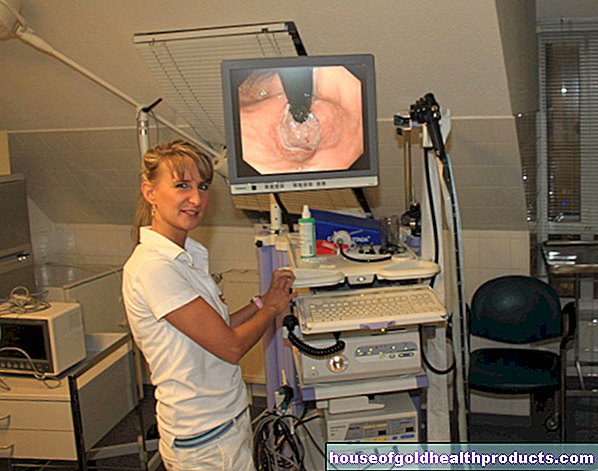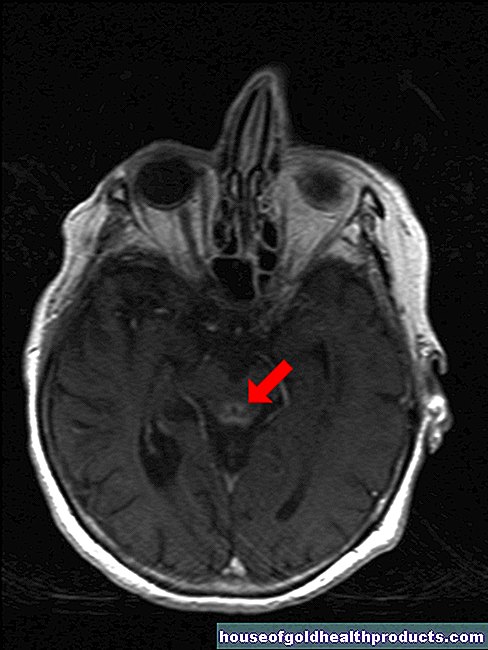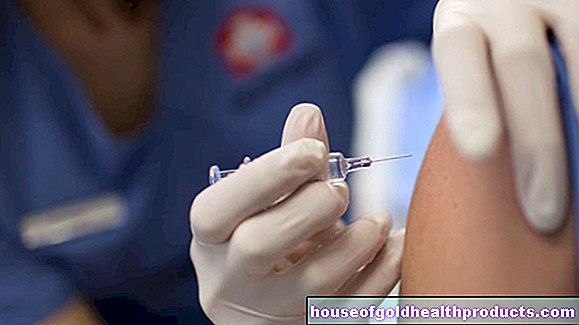Amniotic fluid examination
Nicole Wendler holds a PhD in biology in the field of oncology and immunology. As a medical editor, author and proofreader, she works for various publishers, for whom she presents complex and extensive medical issues in a simple, concise and logical manner.
More about the experts All content is checked by medical journalists.With the amniocentesis (amniocentesis), hereditary diseases and deviations in the genome of a child can be determined while still in the womb. This prenatal examination method also provides information about malformations and infections in children. Find out here when an amniotic fluid test is recommended, how it works and what risks it entails.

What is an amniotic fluid test?
During amniocentesis, the doctor takes some amniotic fluid from the amniotic sac through a hollow needle. Child cells swim in this amniotic fluid, which can be isolated in the laboratory and reproduced in a cell culture. After about two weeks, sufficient genetic material is available to be able to examine it for errors and deviations.
In addition, the concentrations of two proteins in the amniotic fluid are determined: of alpha-fetoprotein (alpha-1-fetoprotein, α1-fetoprotein, AFP) and of the enzyme acetycholinesterase (AChE). Elevated levels of these proteins can indicate malformations of the spine or abdominal wall, especially if both levels are elevated at the same time.
The AFP protein is produced by the yolk sac and the liver of the embryo. In a healthy child, only small amounts of it enter the amniotic fluid via the fetal urine. In the case of malformations such as neural tube defects (open back, etc.), on the other hand, the AFP values are usually significantly increased, as a larger amount is released into the amniotic fluid via the fetal liquor (cerebrospinal fluid). AFP is also determined as part of the so-called triple test - another examination method of prenatal diagnostics, with which the child's risk of trisomy 21 (Down syndrome) is determined in particular.
The protein AChE is an enzyme of the nervous system and is also increased in the case of a neural tube defect.
Amniotic fluid examination: an overview of detectable diseases
The child's genetic material obtained by amniocentesis is carefully analyzed in the laboratory. On the one hand, the structure and number of chromosomes can be examined - the genetic material DNA is organized in the form of 23 double chromosomes. On the other hand, the DNA itself can also be analyzed.
Possible genetic deviations that can result from the chromosome analysis are:
- Trisomy 21 (Down syndrome)
- Trisomy 18 (Edwards Syndrome)
- Trisomy 13 (Patau Syndrome)
In addition, the sex of the child can be determined by examining the chromosomes - some genetic diseases only occur in one of the two sexes.
DNA analysis can reveal hereditary familial diseases and hereditary metabolic disorders.
In addition to the genetic material, the amniotic fluid sample itself can also be examined. With this biochemical analysis, the following diseases can be determined:
- Gaps in the spine (open back = spina bifida)
- Abdominal wall defects (omphalocele, gastroschisis)
- Infections: toxoplasmosis, cytomegalovirus (CMV), amniotic infection syndrome
The biochemical examination can also reveal a possible blood group incompatibility between mother and child (from the 30th week of pregnancy).
If there is a risk of premature birth, doctors can also use the amniocentesis to find out how far the child's lungs have matured. If they are still underdeveloped, drugs can be used to promote lung maturation.
When is an amniotic fluid test recommended?
Amniocentesis is recommended for many pregnant women if there is an increased risk of genetic defects in the child for certain reasons. Such reasons can be:
- Age of pregnant women over 35 years
- Abnormalities in the ultrasound or during the first trimester screening
- familial hereditary diseases such as metabolic or muscle diseases
- an older sibling with a chromosomal disorder
- Previous pregnancies with a neural tube defect or miscarriage due to a chromosomal disorder
If one of the reasons mentioned exists, the health insurance company will cover the costs incurred for the amniotic fluid test.
Amniotic fluid test: when is the best time?
An amniotic fluid test should best be carried out between the 14th and 19th week of pregnancy, i.e. a little later than the chorionic villus sampling (another method of prenatal diagnosis). Before the 14th week of pregnancy, the amniocentesis would not provide any reliable results. In addition, the risk of the examination causing a miscarriage is greater this early in pregnancy. That is why you usually wait at least until the 14th week of pregnancy with the examination.
Depending on the question and problem, the amniotic fluid is occasionally taken at a later point in time (i.e. after the 19th week of pregnancy).
How exactly does the amniotic fluid test work?
The Genetic Diagnostics Act stipulates that every pregnant woman must be informed in detail about the procedure, benefits and risks of the voluntary intervention before the amniocentesis and that the examination must be approved in writing.
An amniotic fluid test is carried out on an outpatient basis in a specialized practice or clinic. Before the puncture, your gynecologist will use ultrasound to check the position of the child and mark the puncture site on your stomach. After careful disinfection, it pierces with a thin hollow needle through the abdominal wall and the uterine wall into the amniotic sac and draws up between 15 and 20 milliliters of amniotic fluid. The cells contained in the liquid obtained are further processed in the laboratory.
The amniotic fluid puncture takes between five and 15 minutes. Most women do not find the procedure painful. Local anesthesia is usually not necessary.
After the amniotic fluid test
Many pregnant women feel a feeling of pressure in the stomach after the amniotic fluid test, but this disappears after a short time. After an observation period of about half an hour, you can leave the practice or the hospital. The doctor will prescribe two to three days of rest and advise you that you should avoid physically strenuous activities and sexual intercourse during this time. In the following days, your doctor will examine you again for a gynecological examination.
If pain, bleeding, amniotic fluid leakage or contractions occur after the amniotic fluid test, you must consult a doctor immediately!
When will the result of the amniotic fluid test be available?
It takes between two and three weeks for the amniotic fluid test to be found - a time that is often very stressful for the parents-to-be and relatives.
Amniotic fluid testing: risk and safety
Complications with amniocentesis are rare. As with any procedure, the amniotic fluid test also involves risks:
- Miscarriage (risk with amniocentesis 0.5 percent; for comparison: with chorionic villus sampling 1 percent)
- premature rupture of the bladder
- Uterine contractions
- Bleeding (rare)
- Infections (rare)
- Injuries to the child (very rare)
The result of the amniotic fluid test provides 99 percent reliable results for chromosomal disorders and 90 percent for neural tube defects. Sometimes a parent's blood test, an ultrasound, another amniocentesis, or a fetal blood test is needed to confirm this.
Amniotic fluid test: yes or no?
You decide for yourself whether you want to have the amniocentesis performed or not. Basically: There is no guarantee for a healthy child. Even if there is a normal set of chromosomes without abnormalities and all values are normal, malformations cannot be ruled out.
The result of an amniotic fluid test says nothing about the formation of gaps in the face, heart defects or deformities in the hands and feet. A high-resolution ultrasound examination between the 20th and 22nd week of pregnancy can provide information about this.
Basically, the benefit and risk of the procedure must be carefully weighed up on an individual basis.
Amniotic fluid examination: a positive result - what now?
If you decide to have a prenatal examination, you should consider beforehand what consequences a positive result would have for you. Chromosome damage or hereditary diseases cannot be cured. The physical impairments in children can vary greatly depending on the impairment and cannot always be clearly predicted.
If you want to terminate the pregnancy based on the positive results, the doctor will first advise you in detail. The result of the amniotic fluid test is only available at an advanced stage of pregnancy. It is then too late for scraping or suction under anesthesia. Instead, an artificial miscarriage has to be initiated with labor-promoting means - a mentally and physically very stressful situation for every woman.
Tags: alcohol sports fitness skin





.jpg)


















.jpg)




